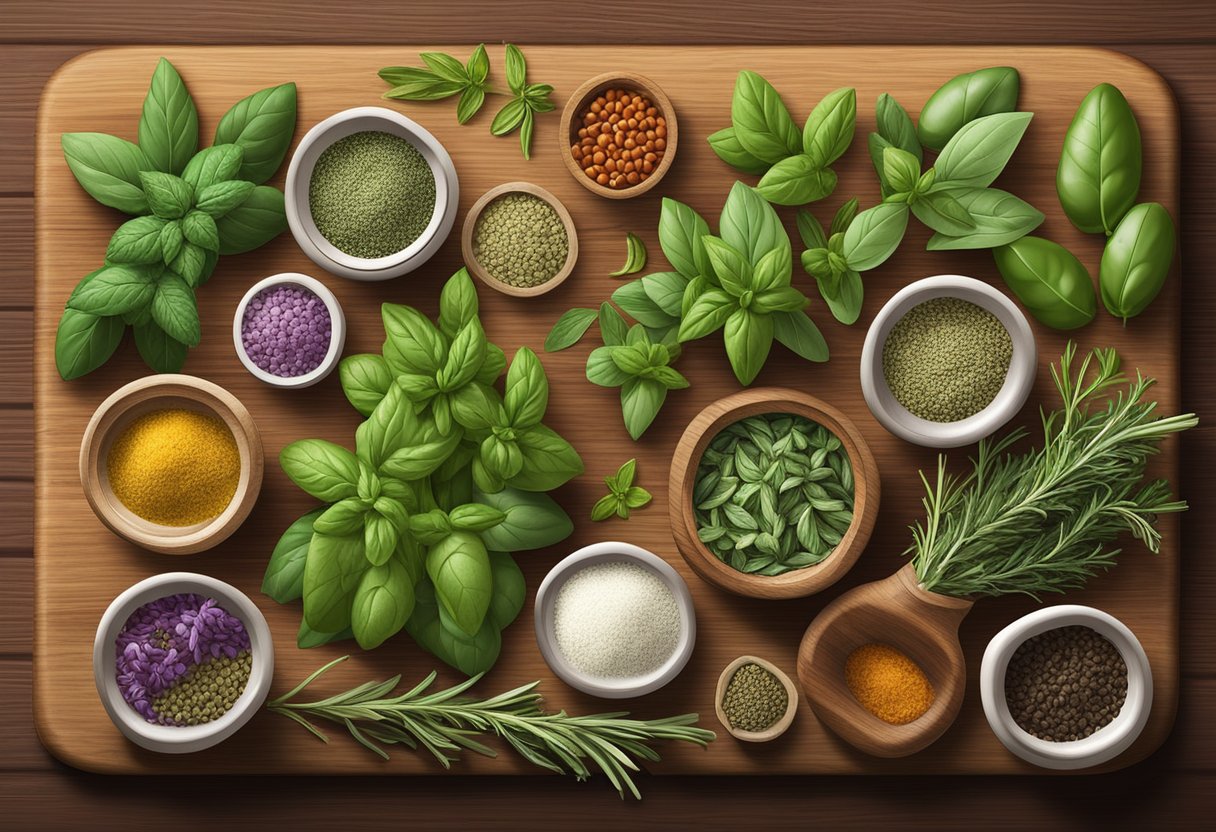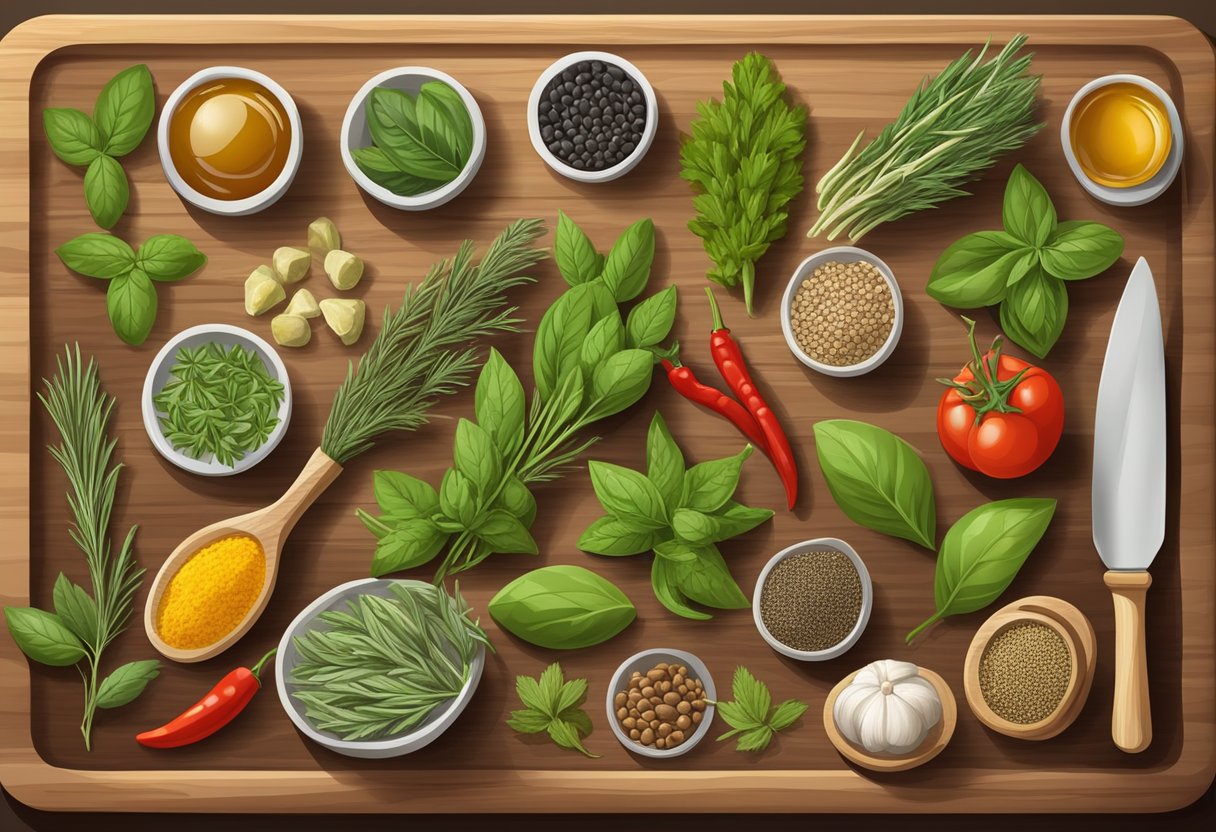The gluten-free Mediterranean diet is a fusion of two healthful eating patterns—the heart-healthy principles of the Mediterranean lifestyle coupled with the dietary needs of individuals with gluten sensitivity or celiac disease. By emphasizing fruits, vegetables, whole grains, nuts, seeds, herbs, spices, and healthy fats, such as olive oil and avocado, this dietary approach offers a diverse and nutrient-rich palette while excluding gluten-containing foods to ensure safe consumption for those who are gluten-intolerant.

Herbs and spices play a central role in the gluten-free Mediterranean diet, not only for their ability to enhance flavor without the use of glutenous thickeners or sauces but also for their potential health benefits. A variety of herbs such as basil, oregano, and rosemary, along with spices like cumin and coriander, are staples that contribute to the distinctive flavors characteristic of Mediterranean cuisine. They also serve to reduce the need for salt and can offer antioxidant and anti-inflammatory properties, aligning with the diet’s overall focus on wellness and disease prevention.
Key Takeaways
- The gluten-free Mediterranean diet combines traditional Mediterranean foods with the necessary avoidance of gluten.
- Herbs and spices are central to flavoring dishes within this diet, reducing the need for salt and providing health benefits.
- This diet emphasizes whole, nutrient-dense foods, supporting both heart health and gluten-free needs.
Table of Contents
Understanding the Gluten-Free Mediterranean Diet

This comprehensive guide offers insight into a lifestyle that fuses the gluten-free approach with the core principles of the Mediterranean diet, aiming to amplify health benefits for individuals, particularly those with celiac disease.
Defining the Gluten-Free Approach
A gluten-free diet eliminates all forms of gluten, a protein found in wheat, barley, and rye. This diet is essential for individuals with celiac disease, as ingesting gluten can lead to serious health complications for them. Gluten-free diets avoid traditional bread, pasta, and cereals, focusing instead on foods like rice, corn, quinoa, and other gluten-free grains.
Core Principles of the Mediterranean Diet
The Mediterranean diet centers around plant-based foods such as vegetables, fruits, nuts, seeds, and legumes. It emphasizes the use of olive oil as a healthy fat source, along with moderate amounts of dairy, protein from fish, poultry, eggs, and occasional helpings of red meat. A characteristic feature of this diet is the inclusion of wine, typically red, consumed in moderation.
Health Benefits of Combining Both Diets
When the gluten-free regimen is integrated with the Mediterranean lifestyle, individuals can experience a multitude of health benefits. This fusion diet not only supports those with celiac disease but may also lower the risk of heart disease, chronic disease, regulate blood pressure, and reduce the likelihood of developing type 2 diabetes and cancer. The combined approach amplifies the benefits of both diets, making it a powerful ally for long-term health.
Key Foods in the Gluten-Free Mediterranean Diet
The Gluten-Free Mediterranean Diet emphasizes whole foods, focusing on a variety of grains and substitutes, an abundance of fruits and vegetables, diverse protein sources, a rich palette of herbs and spices, and the liberal use of healthy fats and oils.

Safe Grains and Substitates
Grains play a fundamental role in this diet. Those on a gluten-free regimen can safely enjoy:
- Rice, including brown and wild varieties
- Corn, often found in polenta or cornmeal
- Buckwheat, despite its name, is gluten-free
- Quinoa, a nutrient-dense pseudo-cereal
- Certified gluten-free oats, ensuring no cross-contamination
Fruits and Vegetables
A vast array of fruits and vegetables offers nutritional wealth:
- Vegetables: Staples include broccoli, cucumbers, potatoes, zucchini, tomatoes, and eggplant.
- Fruits: Prioritize avocado for healthy fats, and berries and cucumbers for hydration and fiber.
Protein Sources
Protein is essential and the Gluten-Free Mediterranean Diet incorporates:
- Fish: Especially tuna and salmon, known for omega-3 fatty acids.
- Poultry and seafood, enjoyed in moderation.
- Eggs, cheese, and Greek yogurt for vegetarians.
Herbs and Spices
Flavor is paramount, and the use of various herbs and spices enhances dishes without compromising gluten-free integrity:
- Basil, rosemary, oregano, parsley, thyme, and sage.
- More exotic tastes from cumin, sumac, cinnamon, marjoram, coriander, fennel, anise, and mint.
Healthy Fats and Oils
Lastly, healthy fats and oils are cornerstones of the diet:
- Olive oil reigns supreme, drizzled over dishes or used in cooking.
- Nuts and seeds, including sesame seeds, walnuts, and others, serve as snacks or garnishes.
- Avocado also provides a nutritious source of fats for any meal.
Meal Planning and Preparation

When adopting a gluten-free Mediterranean diet, meal planning revolves around naturally gluten-free foods rich in nutrients, such as fruits, nuts, legumes, and lean proteins. Below are specific meal ideas that help integrate herbs and spices into each part of the day.
Breakfast Options
For breakfast, individuals can enjoy a bowl of Greek yogurt topped with a mix of fresh fruits and nuts, ensuring a high-protein start with healthy fats. Another option is a gluten-free grain bowl like quinoa or buckwheat, seasoned with cinnamon or turmeric for added flavor and health benefits.
Lunch Ideas
Lunch could consist of vibrant salads with a base of mixed greens, a variety of chopped vegetables, a serving of protein such as grilled chicken or legumes, and a sprinkle of herbs such as basil or oregano. Gluten-free grains like millet can be added for substance, along with a dressing of extra virgin olive oil and lemon juice.
Dinner Recipes
Dinner on a gluten-free Mediterranean diet emphasizes fish or seafood as the main protein, complemented by sides of roasted vegetables and gluten-free grains. Incorporating herbs such as rosemary and thyme can greatly enhance flavor, while a side of leafy greens with nuts and a cheese like feta rounds out the meal.
Snacks and Sides
Snacking in-between meals is an opportunity to eat fruits, nuts, and vegetables such as carrot sticks or bell pepper with hummus. Cheese and yogurt also make for calcium-rich snacks. These can be flavored with a variety of spices, like paprika or cumin, for an extra dimension of taste.
Cultural and Regional Variations

The gluten-free Mediterranean diet embraces the diverse flavors of the region while adapting to dietary restrictions. Each country around the Mediterranean Sea has its own distinct combination of herbs and spices that shape their culinary identity, even when keeping a gluten-free approach.
Mediterranean Spices by Region
- Spain: Saffron and pimentón (smoked paprika) add depth to dishes like paella, which can be made with gluten-free grains.
- Greece: Oregano and thyme are staples, often found in gluten-free Greek salads and marinades for grilled seafood.
- Italy: Basil and fennel seed enhance gluten-free versions of Italian staples like risottos and polenta dishes.
Typical Dishes Across the Mediterranean
- Spain: Gazpacho, a chilled tomato-based soup, utilizes fresh vegetables and olive oil, seasoned with garlic and cumin.
- Greece: Gluten-free moussaka includes layers of eggplant and minced meat, flavored with cinnamon and allspice.
- Italy: Seafood risotto, prepared with Arborio rice and saffron, showcases the country’s penchant for simple yet flavorful gluten-free meals.
Influence of Local Agriculture
- Farming near the Mediterranean Sea yields a bounty of fresh produce, such as tomatoes, eggplants, and peppers, essential for a vibrant gluten-free Mediterranean diet.
- Local markets offer an array of fresh herbs including rosemary, sage, and parsley, that are fundamental to Mediterranean cuisine’s fresh taste.
- The olive, central to the region’s diet, provides olive oil—a healthy fat that is naturally gluten-free and widely used in Mediterranean cooking.
Nutritional Guide

This section provides a detailed look at the nutritional components of herbs and spices within a gluten-free Mediterranean diet, focusing on macronutrients, essential vitamins and minerals, as well as caloric intake for maintaining a balanced diet.
Macronutrients in Focus
Protein: Herbs and spices may offer trace amounts of protein, contributing to the daily intake required for body repair and growth. For example, two teaspoons of coriander seeds provide approximately 0.4 grams of protein.
Fat: Healthy fats are a cornerstone of the Mediterranean diet. Spices like flax seeds can enhance flavors while adding beneficial omega-3 fatty acids.
Carbohydrates: While typically low in carbohydrates, certain herbs and spices add minor amounts, contributing to the overall daily intake. For instance, dried parsley contains about 0.8 grams of carbohydrates per tablespoon.
Fiber: Fiber in herbs and spices, although present in small amounts, aids in digestion and supports weight management by promoting a feeling of fullness.
Vitamins and Minerals Essentials
Herbs and spices are potent sources of various essential vitamins and minerals. For example, thyme is rich in vitamin C, and cumin is noted for its iron content. Integrating a variety of these can help meet nutritional needs without adding gluten to the diet.
- Vitamins: Aromatic herbs like sage and rosemary are rich in vitamins A and K.
- Minerals: Seeds such as sesame might be used as seasoning and are an excellent calcium source.
Monitoring Caloric Intake
Calories in herbs and spices are generally low, making them excellent for flavoring foods without significantly increasing daily calorie intake. Spices like cinnamon can add sweetness to dishes, reducing the need for added sugars and contributing to weight management.
Frequently Asked Questions

Exploring a gluten-free Mediterranean diet requires an understanding of how herbs and spices can be included and which staple ingredients are safe to consume. These FAQs address the key considerations for maintaining a balanced and flavorful diet.
What are common gluten-free spices and seasonings appropriate for the Mediterranean diet?
Common gluten-free spices appropriate for the Mediterranean diet include oregano, basil, rosemary, thyme, and garlic. For authentic flavor, one can also use saffron and sumac with confidence as they naturally contain no gluten Which Spices, Seasonings and Herbs are Gluten-Free?.
How can one ensure spices and herbs used in Mediterranean cuisine are gluten-free?
To ensure that spices and herbs used in Mediterranean cuisine are gluten-free, it is advisable to purchase whole spices and grind them at home. If buying pre-ground spices, one should always check labels for any mention of additives or cross-contamination with gluten-containing ingredients.
What are some key gluten-free ingredients integral to preparing Mediterranean diet recipes?
Key gluten-free ingredients integral to the diet include olive oil, fresh fruits and vegetables, legumes such as lentils and chickpeas, and nuts. One can also use gluten-free grains like quinoa and rice to prepare traditional Mediterranean dishes.
Which gluten-free Mediterranean diet foods are most recommended for a balanced meal plan?
For a balanced meal plan, one should include a high intake of plant-based foods such as vegetables, fruits, and legumes, with olive oil as the main fat source. Lean proteins from fish and seafood should be consumed regularly, while red meat is to be eaten sparingly Combining the Mediterranean Diet and the Gluten-Free Diet.
Where can one find a comprehensive gluten-free Mediterranean diet shopping guide or list?
A comprehensive gluten-free Mediterranean diet shopping guide or list can be obtained from celiac disease associations, nutritionists specializing in gluten-free diets, or from health-focused websites and cookbooks that offer tailored advice for the gluten-free Mediterranean diet.
Are there any popular gluten-free substitutes for traditional Mediterranean ingredients?
Popular gluten-free substitutes for traditional Mediterranean ingredients include almond flour in place of wheat flour for baking, tamari or coconut aminos instead of soy sauce, and using gluten-free pasta alternatives made from rice, corn, or legumes. These substitutes help maintain the integrity of Mediterranean flavors while adhering to a gluten-free diet.



